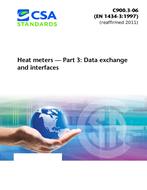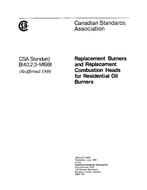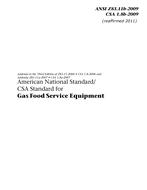Click here to purchase
Preface:
This is the fifth edition of CSA Z150, Safety code on mobile cranes. It supersedes the previous editions published in 2016, 2011, 1998, and 1974.
This Standard is designed to
- guard against and minimize injury to workers, and otherwise provide for the protection of life, limb, health, and property, by specifying minimum safety requirements for mobile cranes;
- provide direction and guidance to manufacturers and buyers of mobile cranes regarding the minimum standards expected of such machines in Canada;
- provide direction and guidance to owners, employers, supervisors, workers, users, and others concerned with, responsible for, or involved in the application and use of mobile cranes; and
- guide Canadian federal, provincial/territorial, and other regulatory bodies in the development and promulgation of appropriate health and safety legislation and directives concerning mobile cranes.
This edition includes the following changes:
Revised requirements on
- wire rope and synthetic rope;
- annual inspection;
- assembly/disassembly;
- cranes not in regular use;
- boom disassembly; and
- personnel lifting (wind speed);
and changes for clarity.
This Standard was developed by CSA Group with funding support provided by the Canadian Association of Administrators of Labour Law — Occupational Safety and Health (CAALL-OSH), including Provincial and Territorial Governments, as well as the Government of Canada. CSA Group is solely responsible for the content of this Standard, and CSA Group and the funding bodies disclaim any liability in connection with the use of the information contained herein.
This Standard has been developed in compliance with Standards Council of Canada requirements for National Standards of Canada. It has been published as a National Standard of Canada by CSA Group.
Scope:
1.1
This Standard describes the design, construction, load rating, installation, erection, inspection, maintenance, repair, modification, test, and operation of lattice and telescopic boom mobile cranes.
Note: See Annex A for illustrations of mobile cranes and Annex B for illustrations of parts of a mobile crane.
1.2
This Standard applies only to machines that have all of the following fundamental characteristics: a) the crane comprises, or is mounted on, a non- or self-propelled, crawler- or wheel-mounted mobile base;
b) the crane is designed and manufactured for the primary purpose of hoisting and lowering loads by means of tackle suspended from a boom;
c) the boom is lattice or telescopic and capable of being elevated and lowered in the vertical plane and of being rotated (swung) from side to side in the horizontal plane;
d) the tackle is suspended from the boom and is capable of being increased and diminished in length; and
e) the crane utilizes an engine(s) or motor(s) of sufficient power to
i) elevate and lower the boom in the vertical plane with the load suspended from the tackle;
ii) rotate (swing) the boom in the horizontal plane with the load suspended from the tackle;
iii) increase and diminish the length of the tackle with the load suspended from the tackle; and
iv) in the case of a self-propelled crane, propel the vehicle, carrier, or base on which or to which the boom and hoist mechanism is attached.
1.3
This Standard applies to crawler-mounted cranes, commercial truck-mounted cranes, boom trucks, wheel-carrier-mounted cranes, railway cranes, locomotive-mounted cranes, and rail-mounted cranes, as well as any variations thereof that retain the fundamental characteristics of these cranes.
1.4
This Standard is applicable only to machines when they are used for lifting (hoisting).
Note: Some basic machine types within this scope are used alternatively for hoisting service and for applications not considered to be hoisting service. All of the requirements of this Standard are applicable to such machines when used for hoisting service. Clause 4.14 contains requirements for machines when used in other than hoisting service.
1.5
Machines within the scope of Clause 1.3, and equipped with hooks, magnets, grapples, clam shell buckets, orange peel buckets, and other devices intended to connect or attach the tackle to the load for the purpose of hoisting or lowering a freely suspended load, are considered to be in lifting (hoisting) service.
1.6
This Standard does not apply to
a) machines within the scope that have been converted or adapted for uses not considered to be lifting (hoisting) services. These conversions and applications include power shovels, excavators, draglines, concrete pumps (see CAN/CSA-Z151), conveyors, augers, drills, and amusement rides (e.g., bungee jumping);
b) articulating boom (knuckle boom) cranes (see CAN/CSA-Z150.3);
c) hydraulic and cable-operated excavating equipment (e.g., power shovels and backhoes);
d) automotive wreckers and tow trucks designed to clear wrecks and haul vehicles;
e) side boom tractors, as used in pipeline work (see ASME B30.14);
f) mobile lifting devices designed specifically for use in power line and electric utility service, such as digger derricks (radial boom derricks) intended to auger holes for and to set power and telephone poles (see ANSI/ASSE A10.31);
g) vehicle-mounted aerial devices (see CAN/CSA-C225);
h) trolley boom cranes (under running trolley hoist);
i) truck-mounted overhead, gantry, and bridge cranes;
j) stacker cranes;
k) self-propelled elevating work platforms (see CAN/CSA-B354.6, CAN/CSA-B354.7, and CAN/CSA-B354.8);
l) lift trucks (forklifts) equipped with booms; and
m) tower cranes (i.e., fixed, climbing, mobile, travelling, and self-erecting) (see CAN/CSA-Z248).
1.7
The values given in SI units are the units of record for the purposes of this Standard. The values given in parentheses are for information and comparison only. 1.8 In this Standard, “shall” is used to express a requirement, i.e., a provision that the user is obliged to satisfy in order to comply with the Standard; “should” is used to express a recommendation or that which is advised but not required; and “may” is used to express an option or that which is permissible within the limits of the Standard. Notes accompanying clauses do not include requirements or alternative requirements; the purpose of a note accompanying a clause is to separate from the text explanatory or informative material. Notes to tables and figures are considered part of the table or figure and may be written as requirements. Annexes are designated normative (mandatory) or informative (non-mandatory) to define their application.
Product Details
- Edition:
- 5th
- Published:
- 06/01/2020
- ISBN(s):
- 9781488329135
- Number of Pages:
- 127
- File Size:
- 1 file , 2 MB
- Product Code(s):
- 2428085, 2428085


